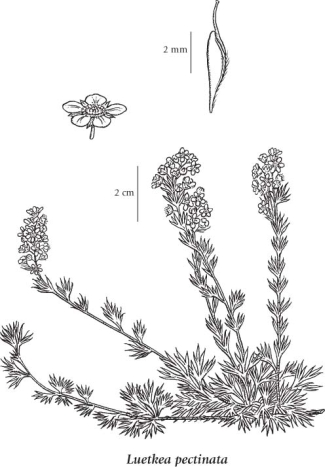Luetkea pectinata (Pursh) Kuntze
partridge-foot (partridgefoot)
Rosaceae (Rose family)
Introduction to Vascular Plants
partridge-foot (partridgefoot)
Rosaceae (Rose family)
Introduction to Vascular Plants
Species Information
General:
Prostrate, mat-forming, semi-shrub from a rhizome and branching stolons; flowering stems erect to ascending, 5-20 cm tall, smooth or sparsely soft-hairy in grooves along the stem.
Leaves:
Evergreen, smooth, dead leaves withering and persistent for many years; basal leaves numerous, crowded in thick tufts, 7-20 mm long, the narrowly wing-margined stalk about as long as the fan-shaped blade, which is two- to three-times 3-dissected, the ultimate segments linear-lanceolate, sharp-pointed, ribbed below, grooved above; stem leaves alternate, similar but smaller.
Flowers:
Inflorescences dense, narrow, bracted, erect, terminal clusters, 1-7 cm long, of several to many short-stalked flowers; corollas white, saucer-shaped, the petals 5, egg- to spoon-shaped, 3-4 mm long; calyces 5-lobed, the lobes triangular, about 2 mm long; ovaries superior; stamens about 20.
Fruits:
Follicles, 4-5 mm long, short-stalked, somewhat leathery, smooth or sparsely silky-hairy along the ventral suture; seeds 4, spindle-shaped.
Illustration

If more than one illustration is available for a species (e.g., separate illustrations were provided for two subspecies) then links to the separate images will be provided below. Note that individual subspecies or varietal illustrations are not always available.
Illustration Source: The Illustrated Flora of British Columbia
Ecology
Ecological Framework for Luetkea pectinata
The table below shows the species-specific information calculated from
original data (BEC database) provided by the BC Ministry of Forests and Range.
(Updated August, 2013)
The table below shows the species-specific information calculated from
original data (BEC database) provided by the BC Ministry of Forests and Range.
(Updated August, 2013)
| Site Information |
Value / Class |
||
|
Avg |
Min |
Max |
|
| Elevation
(metres) |
1711 | 15 | 2500 |
| Slope
Gradient (%) |
27 | 0 | 120 |
|
Aspect (degrees) |
208 | 0 | 360 |
| Soil
Moisture Regime (SMR) [0 - very xeric; 4 - mesic; 8 - hydric] |
3 | 0 | 8 |
| Modal
Nutrient Regime
Class |
C | ||
| #
of field plots species was recorded in: |
1443 | ||
| Modal
BEC Zone Class |
ESSF | ||
|
All BEC Zones (# of stations/zone) species was recorded in |
AT(53), BAFA(79), CMA(78), CWH(31), ESSF(823), ICH(1), IMA(51), MH(225), SBS(2), SWB(13) | ||
|
Source:
Klinkenberg 2013
|
|||
Habitat and Range
Mesic to wet forest openings, meadows, heathlands, scree slopes, mossy seepage areas and snowbed tundra in the subalpine to alpine zones; common throughout BC, except NE; N to AK, YT and NT, E to W AB and S to ID, MT and N CA.Status Information
Synonyms
Synonyms and Alternate Names:
Saxifraga pectinata Pursh, non Schott, Nyman & Kotschy